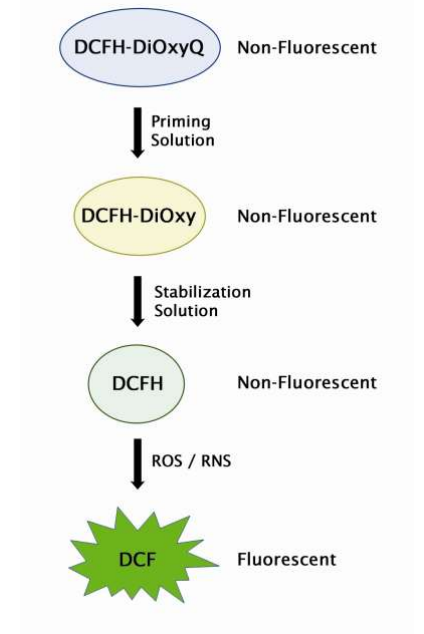Description
OxiSelect™ In Vitro ROS/RNS Assay Kit (Green Fluorescence)
Introduction:
Reactive oxygen species (ROS) and reactive nitrogen species (RNS) are well-established molecules
responsible for the deleterious effects of oxidative stress. Accumulation of free radicals coupled with
an increase in oxidative stress has been implicated in the pathogenesis of several disease states. The
role of oxidative stress in vascular diseases, diabetes, renal ischemia, atherosclerosis, pulmonary
pathological states, inflammatory diseases, cancer, as well as ageing has been well established. Free
radicals and other reactive species are constantly generated in vivo and cause oxidative damage to
biomolecules, a process held in check by the existence of multiple antioxidant and repair systems as
well as the replacement of damaged nucleic acids, proteins and lipids. Measuring the effect of
antioxidant therapies and ROS/RNS activity is crucial to suppressing or treating oxidative stress
inducers.
The OxiSelect™ In Vitro ROS/RNS Assay Kit is an assay for measuring the total free radical presence
of a sample. The assay employs a proprietary quenched fluorogenic probe, dichlorodihydrofluorescin
DiOxyQ (DCFH-DiOxyQ), which is a specific ROS/RNS probe that is based on similar chemistry to
the popular 2’, 7’-dichlorodihydrofluorescein diacetate. The DCFH-DiOxyQ probe is first primed with
a quench removal reagent, and subsequently stabilized in the highly reactive DCFH form. In this
reactive state, ROS and RNS species can react with DCFH, which is rapidly oxidized to the highly
fluorescent 2’, 7’-dichlorodihydrofluorescein (DCF) (Figure 1). Fluorescence intensity is proportional
to the total ROS/RNS levels within the sample. The DCFH-DiOxyQ probe can react with hydrogen
peroxide (H2O2), peroxyl radical (ROO·), nitric oxide (NO), and peroxynitrite anion (ONOO-
). These
free radical molecules are representative of both ROS and RNS, thus allowing for measurement of the
total free radical population within a sample. OxiSelect™ In Vitro ROS/RNS Assay Kit can also be
used to evaluate antioxidant’s effect on free radicals. The kit has a detection sensitivity limit of 10 pM
for DCF and 40 nM for H2O2 respectively. Each kit provides sufficient reagents to perform up to 96
assays, including standard curve and unknown samples.
Assay Principle:
The OxiSelect™ In Vitro ROS/RNS Assay Kit is an in vitro assay for measuring total ROS/RNS free
radical activity. Unknown ROS or RNS samples or standards are added to the wells with a catalyst
that helps accelerate the oxidative reaction. After a brief incubation, the prepared DCFH probe is
added to all wells and the oxidation reaction is allowed to proceed (Figure 1). Samples are measured
fluorometrically against a hydrogen peroxide or DCF standard. The assay is performed in a 96-well
fluorescence plate format that can be read on a standard fluorescence plate reader. The free radical
content in unknown samples is determined by comparison with the predetermined DCF or hydrogen
peroxide standard curve.

Kit Components:
1. Priming Reagent (Part No. 234701): One 250 µL tube of solution.
2. Stabilization Solution (10X) (Part No. 234702): One 1.5 mL tube of solution.
3. Catalyst (250X) (Part No. 234703): One 20 µL tube of solution.
4. DCF-DiOxyQ (Part No. 234704): One 50 µL amber tube of solution in methanol.
5. DCF Standard (Part No. 234202): One 100 µL amber tube of a 1 mM solution in DMSO.
6. Hydrogen Peroxide (Part No. 234102): One 100 µL amber tube of an 8.821 M solution.
Materials Not Supplied:
1. 10 µL to 1000 µL adjustable single channel micropipettes with disposable tips
2. 50 µL to 300 µL adjustable multichannel micropipette with disposable tips
3. Multichannel micropipette reservoir
4. Phosphate Buffered Saline for sample preparations and dilutions
5. 96-well black or fluorescence microtiter plate
6. Fluorescent microplate reader capable of reading 480 nm (excitation) and 530 nm (emission)
Storage:
Upon receipt, store the DCF-DiOxyQ and DCF Standard at -20ºC. Avoid multiple freeze/thaw cycles.
Store all other components at 4ºC.






